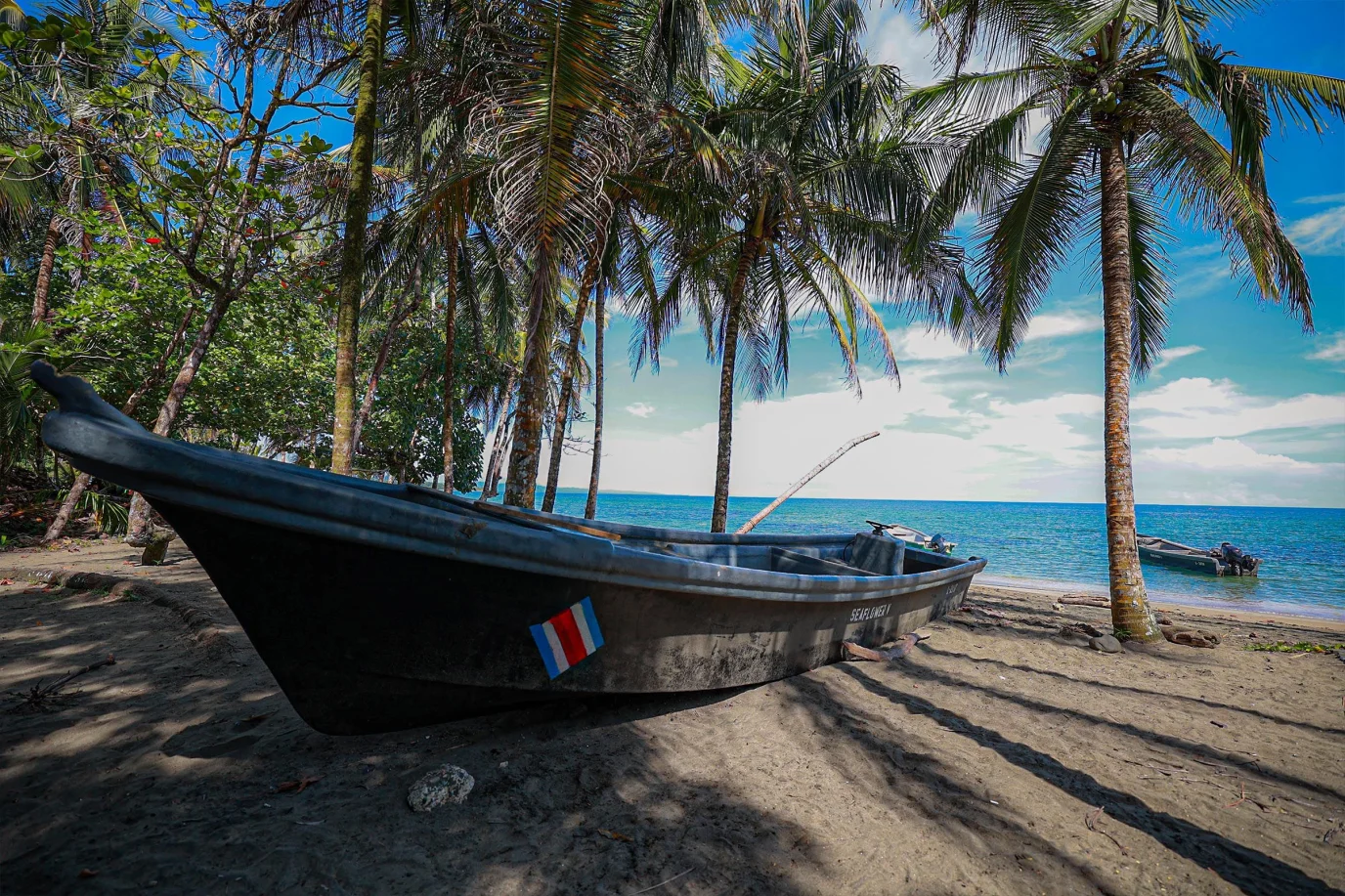Caribbean Coast at a Glance
Highlights:
- Virgin lowland forests
- Navigable canals
- Key turtle nesting sites
- Abundant and unique wildlife
- Tarpon fishing
- Fewer visitors/less touristy
- Patua language and culture
National Parks:
- Tortuguero National Park
- Barra del Colorado Wildlife Refuge
Beaches:
- Cahuita
- Puerto Viejo
- Manzanillo
Perhaps the most underestimated region of Costa Rica is its northeastern Caribbean Coast.
Unlike its Pacific counterpart, the Caribbean Coast of Costa Rica is not known for its tourist-friendly swimming beaches or luxury hotels. The draw is the unspoiled and unaltered flora and fauna, which have attracted eco-travelers and nature lovers for decades.
Together, the Tortuguero National Park and the Barra del Colorado Nature Reserve make up one of the largest virgin lowland rainforests in the world.
It may feel like you time traveled after spending a few days in what is often referred to as the ‘Venice of Costa Rica’. Accessible only by a small plane or boat, it’s easy to see how the area got this nickname. Freshwater canals take the place of roads while banana boats replace cars.
In recent years the area has grown and now modern comforts are more easily available, but raw nature still dominates in this corner of Costa Rica.
Sea Turtles, Monkeys, & Other Marine Wildlife in Costa Rica
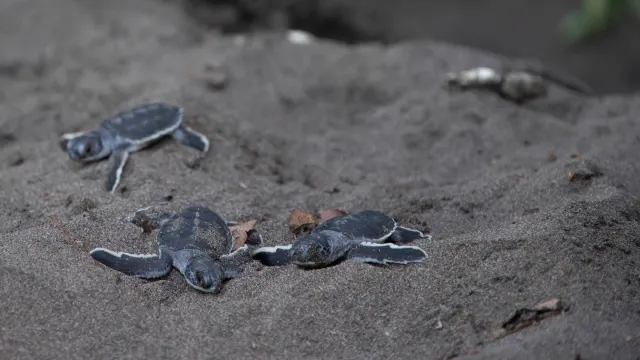
Certainly one of the reasons the Caribbean presents protected areas and is so popular is the sea turtles that return here.
In total, there are four different types of turtles that nest here each year:
- Hawksbill
- Loggerhead
- Green turtle
- Leatherbacks
Their habits and seasons vary a little, so make sure to consult a Travel Expert about when is the best time and place to see them.
In addition to the huge assortment of monkeys, birds, snakes and frogs that are also found here, it is a very common site to see crocodiles sunning themselves along the banks of the canals.
The combination of all this wildlife, untouched rainforest, quiet freshwater canals, unexplored lagoons, and the open Caribbean Sea makes for a rich, varied, and off-the-beaten path destination.
Fishing for the Silver King in the Caribbean Coast
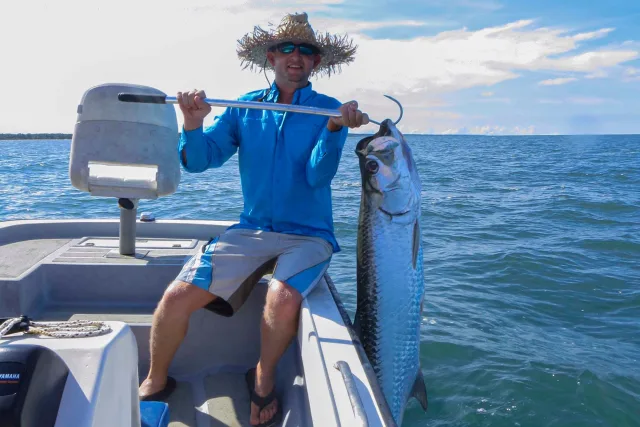
Most visitors look at the Pacific Coast when they think of fishing as their main activity, but the Caribbean offers a special treats for anglers of all ages.
Without a doubt the main attraction for anglers is the huge tarpon that are found here. Appropriately named the ‘silver king’, these beasts average 100-120 lbs and can reach mammoth proportions of over 200 lbs!
Besides their sheer size, what makes these fish a favorite among sport fishermen is their strength and fighting ability. A tarpon may actually be the most difficult game fish to boat because the fight can last for hours and they are experts at throwing hooks.
Extremely hard runs and spectacular jumps of 6-7 ft into the air are what make tarpon fishing so popular. Tarpon are found in freshwater canals and rivers as well as in the Caribbean Sea near river mouths and reefs.
The backwater lagoons also offer a serene fishing setting as you can find Machaca, Mojarra, and the delicious Guapote (Rainbow Bass) as you listen to the sounds of the rainforest. Inshore fishing is always exciting as you will find big Snook, Snapper, Jacks, and Kingfish in the river mouths or within a few miles of shore.
Of course, if you are looking for something different or just prefer offshore fishing, with a quick 40 minute run you can be fishing for tuna, wahoo, dorado, and sailfish out in the Caribbean.
Tortuguero National Park: River Canals, Turtles & Sparkling Waters
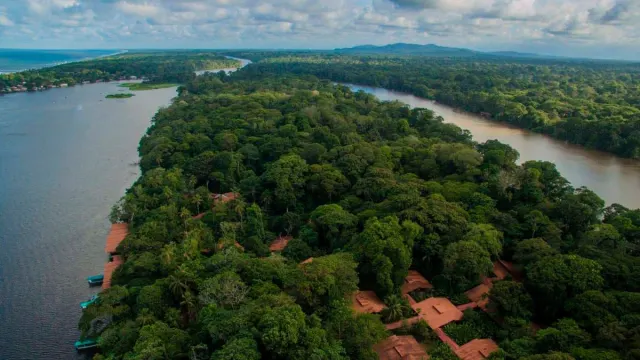
A true wonder for wildlife enthusiasts, Tortuguero National Park offers a stunning, 22-mile-long, turtle nesting beach, with abundant greenery that covers thousands of calm, river canals, bursting with wildlife.
When to visit Tortuguero National Park:
- Year-round, peak months are February to April & July to October.
What to do:
- Sea turtle spotting tours
- Bird & wildlife watching in the canals
- Canopy tours
- Hiking
- Sportfishing
Where to go:
- Barra del Colorado Wildlife Refuge
- Cariari National Wetlands
- Sea Turtle Conservancy
Located in the Northeastern region of Costa Rica on the Caribbean Coast, Tortuguero National Park is the third most popular park in the country.
This park is part of the larger Tortuguero Conservation Area, whose aim is to protect endangered species in the region.
With more than five different habitats, Tortuguero is one of the richest biological destinations in the country. It’s famous for being the nesting ground for several species of endangered turtles including the green sea turtle and the leatherback.
Entrance to the park is in the village of Tortuguero, and then visitors can decide if they want to try the water at the beach and canals, or the hiking routes in the jungle.
When traversing the waters, people often spot manatees, caimans, crocodiles, and tropical gar. Visitors on the hiking paths can see monkeys, peacocks, toucans, sloths, and, if they’re very lucky, jaguars.
Turtles are of course the most popular attraction, and thousands of visitors arrive each year hoping to see sea turtles come to shore to lay eggs or see the newborns hatch from their eggs and go on their first swim. Guided tours are necessary to guarantee the birth process remains undisturbed.
The nesting season for the green sea and hawksbill turtles is during the rainy season: July to October (peak is in August). For leatherback turtles peak months are February to April. And no worries, it is possible to see individual turtles at any time of the year, so you can check into a lodge during your vacations to enjoy the area.
Barra del Colorado Wildlife Refuge
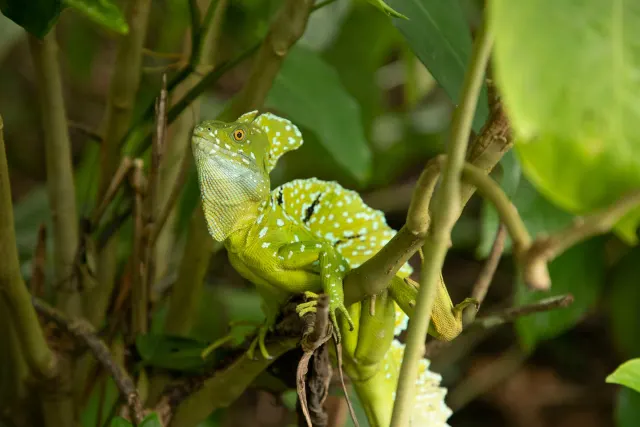
Home of the endangered West Indian manatee, Barra del Colorado Wildlife Refuge is the second-largest rainforest preserve in Costa Rica. This means it’s significantly quieter than some of the country’s more popular national parks.
When to visit Barra del Colorado:
- Dry season, from February to April
What to do:
- Canoeing
- Kayaking
- Sportfishing
- Hiking
- Wildlife spotting
Where to go:
The Barra del Colorado Wildlife Refuge is located on the lush green exotic Caribbean Coast, in the province of Limon, between the San Juan River and the Tortuguero National Park.
Boasting more than 227,000 acres of dense jungle, it’s an ideal destination for adventurous travelers.
Boasting more than 227,000 acres of dense jungle, it’s an ideal destination for adventurous travelers.
It’s one of the largest and most remote conservation areas in Costa Rica. Its stunning natural beauty is matched only by its isolation, as it remains one of the most difficult national parks to access in the country.
The journey is well worth it – Barra del Colorado Wildlife Refuge is home to some of the most exotic wildlife in Central America, including several species. It hosts monkeys, crocodiles, sloths, frogs, toucans, red macaws, myriads of other tropical birds, and the highly endangered West Indian manatee. It also consists mainly of wetlands and rainforest.
The refuge also has abundant lagoons, creeks, and rivers, which can make for a good sportfishing destination. The waters hold Snapper, Tarpon, and Snook, some of which can weigh up to 100 pounds. It’s possible to rent a boat to go fishing within the park or along the San Juan and Colorado rivers.
Even if you’re not into fishing, the peaceful waterways that wind through Barra del Colorado are perfect for getting back to nature and enjoying the tropical wildlife.
There are many luxurious eco-lodges located along the banks of the two rivers, and kayaking down these serene waters will make you feel as though you’re exploring a land lost in time.
Cahuita Beachtown: The Best of the South Caribbean
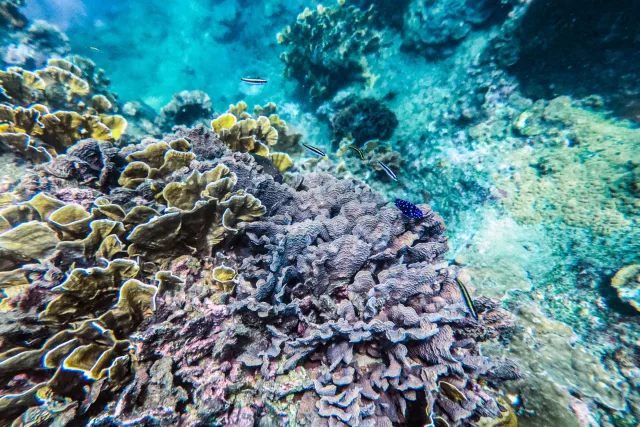
Cahuita is a relaxing little Caribbean paradise located south of the city of Limón. With a unique culture and Afro-Caribbean heritage, Cahuita brings a whole set of rhythms, colors, and flavors to your vacation.
What to do in Cahuita:
- Scuba diving & snorkeling
- Swimming
- Fishing
- Boat trips
- Mountain biking
- Hiking
- Horseback riding
Where to go:
- Cahuita National Park
- Aviarios Sloth Sanctuary
- Gandoca-Manzanillo Wildlife Refuge
- Bri Bri Indigenous Reserve
This entire region is really set apart from the rest of Costa Rica as it has maintained its strong Caribbean culture: reggae music, coconut rice and beans, a laid back atmosphere, slow pace of life, white sand beaches, and the classic Costa Rican friendliness you experience during a vacation here.
The roots of Cahuita can be traced back to Afro-Caribbean fishermen and workers who were brought there from Jamaica to build the railway in the middle of the 1800’s. While Spanish is also spoken fluently you will find that in this area most people also speak very good English.
Today Cahuita is home to about 4,000 residents of which many come from Europe and the USA. The little town has a lively and young atmosphere, a place where people like to have a good time and relax while enjoying the natural gifts of nature.
It has an amazing choice of very good restaurants offering Afro-Caribbean specialties such as jerked chicken and curried goat. Find a variety of French and Italian cuisine as well, along with a good selection of lively bars.
Cahuita’s main attraction is the Cahuita National Park. To the West is the dark-sanded Cahuita Beach ,which both the town and the park are named after. On the Eastern side begins a series of magnificent white sand beaches and tropical wild forests that are part of the Park.
Created in 1970 to protect the biggest coral reef of Costa Rica, the Cahuita National Park holds 22,400 hectares of ocean and marine life, as well as a land area of 1,067 hectares that includes rainforest, littoral woodland, and flora and swamp forest.
Walk the trails along the littoral and come across howler monkeys, white-faced capuchins, iguanas, basilisks, sloths, agoutis, as well as several species of birds including herons, ibises, kingfishers and gulls.
Make sure to spot the famous coral reef that was damaged during an earthquake in 1991.
It has at least 35 species of coral and 500 species of fish, and visitors come from all over the world to go snorkeling or scuba diving in its blue waters. There live blue parrot fish, green turtles, angel queen fish, lobsters, manta rays, three species of sharks, and more.
The waters of the park hold one more secret: two sunken ships! While the chances of finding a treasure are slim, they are still fun to see with their exposed cannon reminiscent of some ancient battles.
Puerto Viejo: Beach Vibes, History & Culture
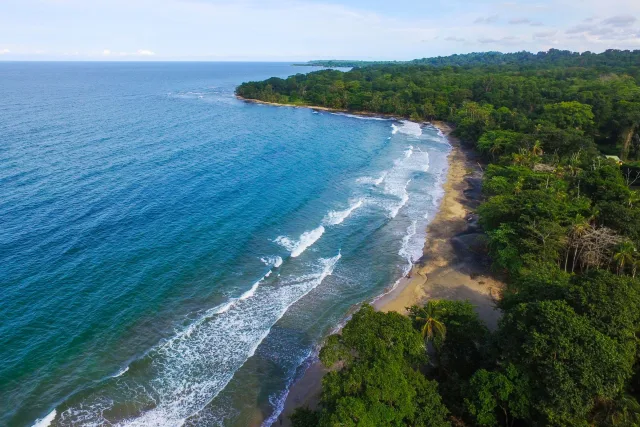
Anybody searching for a taste of Costa Rica’s Caribbean culture and nature will find Puerto Viejo a perfect fit. With a combination of history, a colorful food scene, and surfing culture, Puerto Viejo is the largest town on the southern Caribbean coast and the main tourist center of the region.
What to do in Puerto Viejo:
- Surfing
- Whitewater rafting
- Wildlife watching
- Scuba diving & snorkeling
- Canopy tours
- ATV tours
Where to go:
- Cahuita National Park
- Sloth sanctuary
- Gandoca-Manzanillo Wildlife Refuge
- Bri Bri Indigenous Reserve
The Caribbean Coast of Costa Rica has a very particular culture. When the reggae starts and ticos greet you with a “wh’appin” (what’s happening?), then you know you’ve arrived.
Currently a town of around 2,000 inhabitants, Puerto Viejo is a beachtown on the Southern Carribean Coast. Originally called Old Port by the Jamaicans who settled this area in the 19th century, the name changed to its direct Spanish translation of Puerto Viejo as part of a Costa Rican government program.
The variety in the town is outstanding – there are more than 40 different nationalities amongst those living there, from indigenous Bribri Native Americans to the local Afro-Caribbean community and a growing population of Latinos from other parts of Costa Rica and Central America.
An eclectic selection of Europeans, North and South Americans have also arrived to claim their little piece of paradise, and German, French and Portuguese are about as common as English, Bribri, and Spanish. Rice’n’beans, curried goat, and chicken. Yep, this is the Caribbean!
The beaches in this area are pristine, with steaming green jungles meeting white sand and coral reef-fringed waters.
From Cahuita National Park to Cocles (winner of Costa Rica’s “Blue Flag” program for clean beaches) and Manzanillo, these beaches are the true richness of the area.
The surf is also colossal. Salsa Brava, the reef break right in town is world-famous and absolutely Costa Rica’s biggest, best, and most powerful wave.
Salsa Brava means “angry sauce,” which means this wave is not for the lighthearted, and definitely not for the beginner.
This is a wave that surfing legends are born in. For those not willing to brave Salsa Brava, Cocles Beach has a decent beach break, and is a short walk outside of town. This beach is also great for relaxing and hanging out, and has some of Puerto Viejo’s best hotels in the vicinity.
Puerto Viejo has a wide variety of accommodations from budget hostels catering for the student/traveler/party scene to higher-end boutique lodges for those wanting a unique place to disappear into.
The eclectic population has directly led to one of the best restaurant and bar scenes in Costa Rica, and Puerto Viejo is a place where the party animal will never get bored.
Those looking for a more relaxed time will certainly have no problem chilling out, Caribbean-style, just out of town on Cocles Beach and towards Manzanillo.
Puerto Viejo and the southern Caribbean Coast definitely offer the visitor a mixture of adventure, excitement and relaxation.
Manzanillo: Stunning Natural Wonders
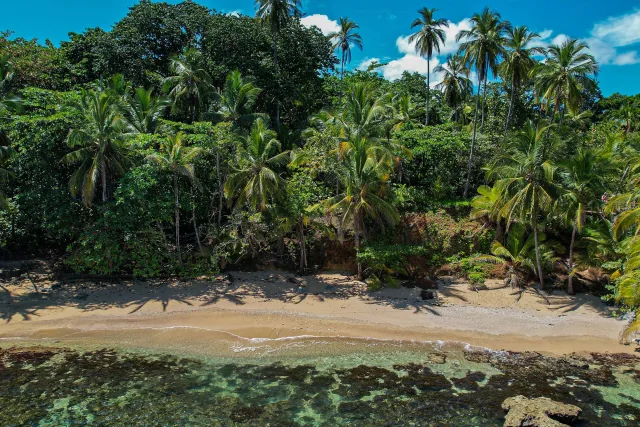
Arguably one of the Caribbean’s most beautiful beaches, Manzanillo boasts white sands and stunning waters.
Protected by the Gandoca Manzanillo Wildlife Refuge, Manzanillo is known for its picturesque beaches and diverse wildlife ranging from manatees, dolphins, and several species of sea turtles which come to nest on the beach on February-May.
What to do in Manzanillo:
- Kayaking
- Snorkeling
- Swimming
- Nesting sea turtle tour
Where to go:
- Gandoca Manzanillo Wildlife Refuge
Picture a rustic Caribbean coastline with white sands and stunning blue water surrounded by lush vegetation. Welcome to Manzanillo, a hidden treasure nestled near the Panamanian border of Costa Rica’s Limon province.
Far quieter than the beaches of neighboring Puerto Viejo to the north, on a quiet day one can feel that they are completely alone on a deserted Caribbean coastline.
Protected by the Gandoca Manzanillo Wildlife Refuge, the palm-lined beaches offer a tropical paradise and the protected coral reef is popular with scuba divers and snorkelers alike.
If you feel like exploring, walk along trails to reach other pockets of sand, or hike up through short path to see rock formations in the water.
Don’t forget your camera – capture the plethora of flora and fauna on, in and around the waters and sands of Manzanillo. Be sure to bring a snorkel and mask to take a peek at the underwater beauty, or hire equipment in the area.
Amongst the abundance of wildlife, you may be lucky enough to spot coral reefs with lobsters, sponges, urchins, anemones, manatees, dolphins and species of sea turtles, such as the green sea turtle, which nests on the beaches of Manzanillo from February through May, the leatherback and hawksbill.
Swim in the warm waters and look for hidden underwater treasures, or rest under the shade of a palm tree. Bring a towel and some snacks and simply relax to the sounds of the ocean – with plenty of secluded beach to explore, you may find a nook where it’s just you and the sound of the ocean.
The area is hot and humid year-round. Manzanillo receives rainfall throughout the year and there is not a clearly defined dry/green season like in other parts of Costa Rica. It is because of this rainfall that the area is blessed with lush, green surroundings at all times of the year.
The remote location of Manzanillo beach and its lush tropical climate make it the perfect home to a large number of birds, marine and wildlife species. It is a rich area for birding with the protected areas providing home to species of hawks, owls and a plethora of other tropical birds.
